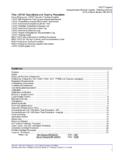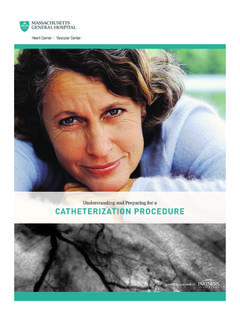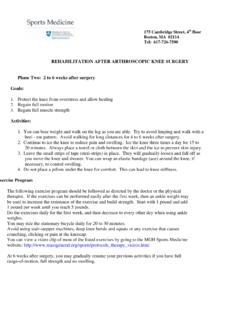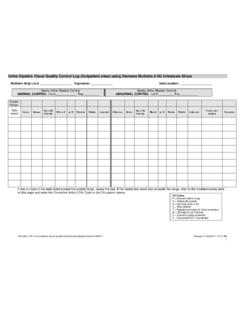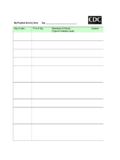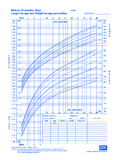Transcription of Rehabilitation Protocol for Rotator Cuff Repair-Small to ...
1 Rehabilitation Protocol for Rotator cuff Repair-Small to Medium Sized Tears This Protocol is intended to guide clinicians and patients through the post-operative course of a Rotator cuff repair. Specific interventions should be based on the needs of the individual and should consider exam findings and clinical decision making. If you have questions, contact the referring physician. Considerations for the Post-operative Rotator cuff Repair Rehabilitation Program Many different factors influence the post-operative Rotator cuff repair Rehabilitation outcome, including Rotator cuff tear size, type of repair, tissue quality, number of tendons involved, and individual patient factors like age and co-morbidities including increased BMI and diabetes.
2 Consider taking a more conservative approach for more complex tears, including large/massive tears (>3 cm) and >1 tendon involvement. Post-operative Complications If you develop a fever, unresolving numbness/tingling, excessive drainage from the incision, uncontrolled pain or any other symptoms you have concerns about you should contact the referring physician. PHASE I: IMMEDIATE POST -OP (0-3 WEEKS AFTER SURGERY). Rehabilitation Protect surgical repair Goals Reduce swelling, minimize pain Maintain UE ROM in elbow, hand and wrist Gradually increase shoulder PROM.
3 Minimize muscle inhibition Patient education Sling Neutral rotation Use of abduction pillow in 30-45 degrees abduction Use at night while sleeping Precautions No shoulder AROM/AAROM. No lifting of objects No supporting of body weight with hands Avoid scapular retraction with a teres minor repair Intervention Swelling Management Ice, compression Range of motion/Mobility PROM: ER<20 scapular plane, Forward elevation <90, seated GH flexion table slide, horizontal table slide AROM: elbow, hand, wrist (PROM elbow flexion with concomitant biceps tenodesis/tenotomy).
4 AAROM: none Strengthening (Week 2). Periscapular: scap retraction*, prone scapular retraction*, standing scapular setting, supported scapular setting, inferior glide, low row o *avoid with subscapularis repair and teres minor repair Ball squeeze Criteria to 90 degrees shoulder PROM forward elevation Progress 20 degrees of shoulder PROM ER in the scapular plane 0 degrees of shoulder PROM IR in the scapular plane Palpable muscle contraction felt in scapular and shoulder musculature No complications with Phase I. PHASE II: INTERMEDIATE POST-OP (4-6 WEEKS AFTER SURGERY).
5 Rehabilitation Continue to protect surgical repair Goals Reduce swelling, minimize pain Maintain shoulder PROM. Minimize substitution patterns with AAROM. Patient education Sling Neutral rotation Use of abduction pillow in 30-45 degrees abduction Use at night while sleeping Precautions No lifting of objects No supporting of body weight with hands Intervention Range of motion/Mobility *Continue with PROM: ER<20 scapular plane, Forward elevation <90. Phase I AAROM: Active assistive shoulder flexion, shoulder flexion with cane, cane external rotation stretch, interventions washcloth press, sidelying elevation to 90 degrees Strengthening Periscapular: Row on physioball, shoulder extension on physioball Criteria to 90 degrees shoulder PROM forward elevation Progress 20 degrees shoulder PROM ER in scapular plane 0 degrees of shoulder PROM IR in the scapular plane Minimal substitution patterns with AAROM.
6 Pain < 4/10. No complications with Phase II. PHASE III: INTERMEDIAT E POST-OP CONTD (7-8 WEEKS AFTER SURGERY). Rehabilitation Do not overstress healing tissue Goals Reduce swelling, minimize pain Gradually increase shoulder PROM/AAROM. Initiate shoulder AROM. Improve scapular muscle activation Patient education Sling Discontinue Precautions No lifting of heavy objects (>10 lbs). Intervention Range of motion/Mobility *Continue with PROM: ER<30 scapular plane, Forward elevation <120. Phase I-II AAROM: seated shoulder elevation with cane, seated incline table slides, ball roll on wall interventions AROM: elevation < 120, supine flexion, salutes, supine punch, wall climbs Strengthening Periscapular**: Resistance band shoulder extension, resistance band seated rows, rowing, lawn mowers, robbery, serratus punches **Initiate scapular retraction/depression/protraction with subscapularis and teres minor repair Elbow.
7 Biceps curl, resistance band bicep curls and triceps Criteria to 120 degrees shoulder PROM forward elevation Progress 30 degrees shoulder PROM ER and IR in scapular plane Minimal substitution patterns with AROM. Pain < 4/10. PHASE IV: TRANSITIONAL POST-OP (9-10 WEEKS AFTER SURGERY). Rehabilitation Do not overstress healing tissue Goals Gradually increase shoulder PROM/AAROM/AROM. Improve dynamic shoulder stability Progress periscapular strength Gradually return to full functional activities Precautions No lifting of heavy objects (> 10 lbs). massachusetts general hospital Sports Medicine 2.
8 Intervention Range of motion/mobility *Continue with PROM: ER<45 scapular plane, Forward elevation <155, ER @ 90 ABD < 60. Phase II-III AROM: supine forward elevation with elastic resistance to 90 deg, scaption and shoulder flexion to interventions 90 degrees elevation Strengthening Periscapular: Push-up plus on knees, prone shoulder extension Is, resistance band forward punch, forward punch, tripod, pointer Criteria to 155 degrees shoulder PROM forward elevation Progress 45 degrees shoulder PROM ER and IR in scapular plane 60 degrees shoulder PROM ER @ 90 ABD.
9 120 degrees shoulder AROM elevation Minimal to no substitution patterns with shoulder AROM. Performs all exercises demonstrating symmetric scapular mechanics Pain < 2/10. PHASE V: TRANSITIONAL POST-OP CONTD (11-12 WEEKS AFTER SURGERY). Rehabilitation Restore full PROM and AROM. Goals Enhance functional use of upper extremity Intervention Range of motion/mobility *Continue with PROM: Full Phase II-IV AROM: Full interventions Stretching External rotation (90 degrees abduction), Hands behind head, IR behind back with towel, sidelying horizontal ADD, sleeper stretch, triceps and lats, doorjam series Criteria to Full pain-free PROM and AROM.
10 Progress Minimal to no substitution patterns with shoulder AROM. Performs all exercises demonstrating symmetric scapular mechanics Pain < 2/10. PHASE VI: STRENGTHENING POST-OP (13-16 WEEKS AFTER SURGERY). Rehabilitation Maintain pain-free ROM. Goals Initiate RTC strengthening (with clearance from MD). Initiate motor control exercise Enhance functional use of upper extremity Intervention Strengthening *Continue with Rotator cuff : internal external rotation isometrics, side-lying external rotation, Phase II-V Standing external rotation w/ resistance band, standing internal rotation w/ resistance band, interventions internal rotation, external rotation, sidelying ABD standing ABD.
